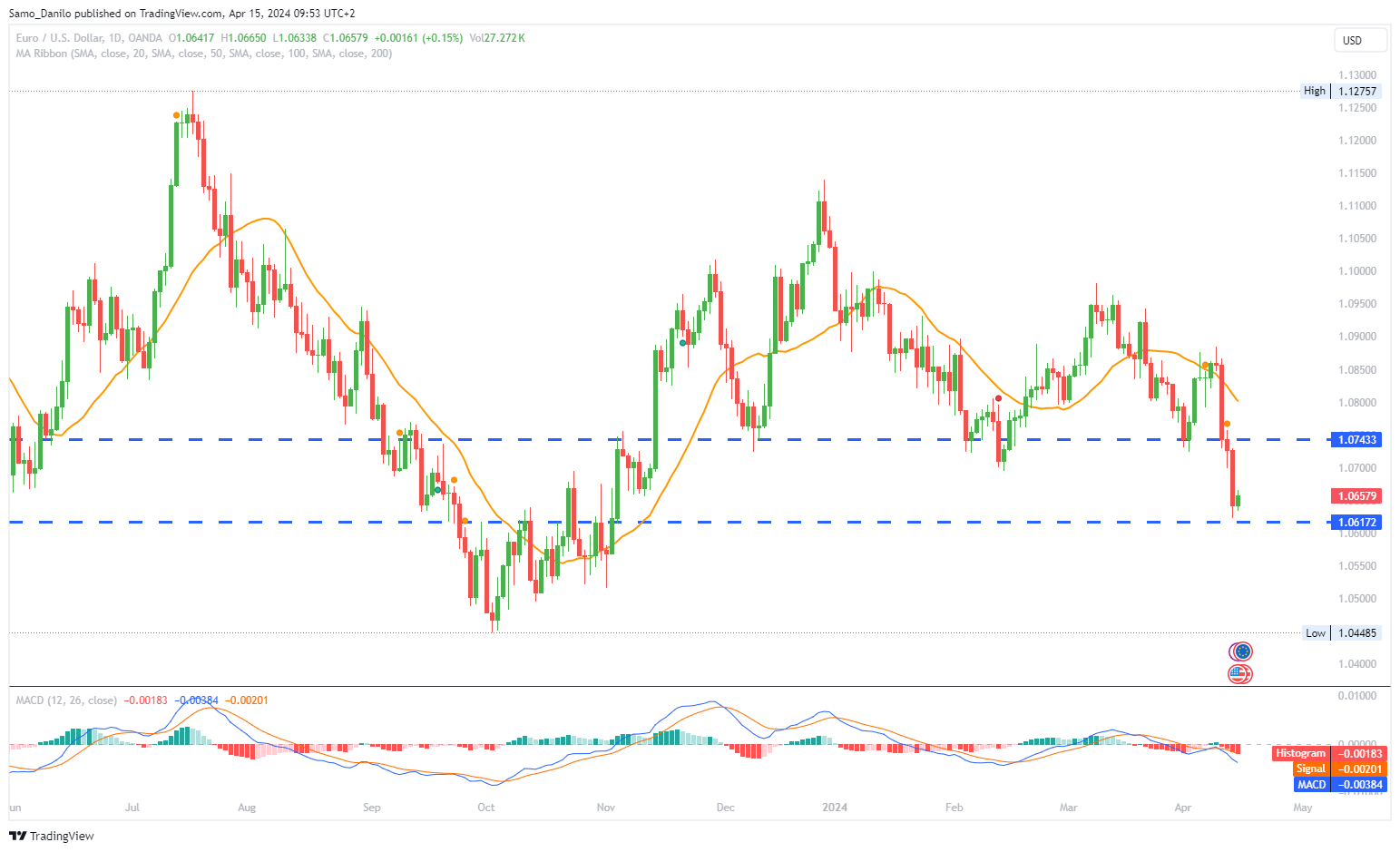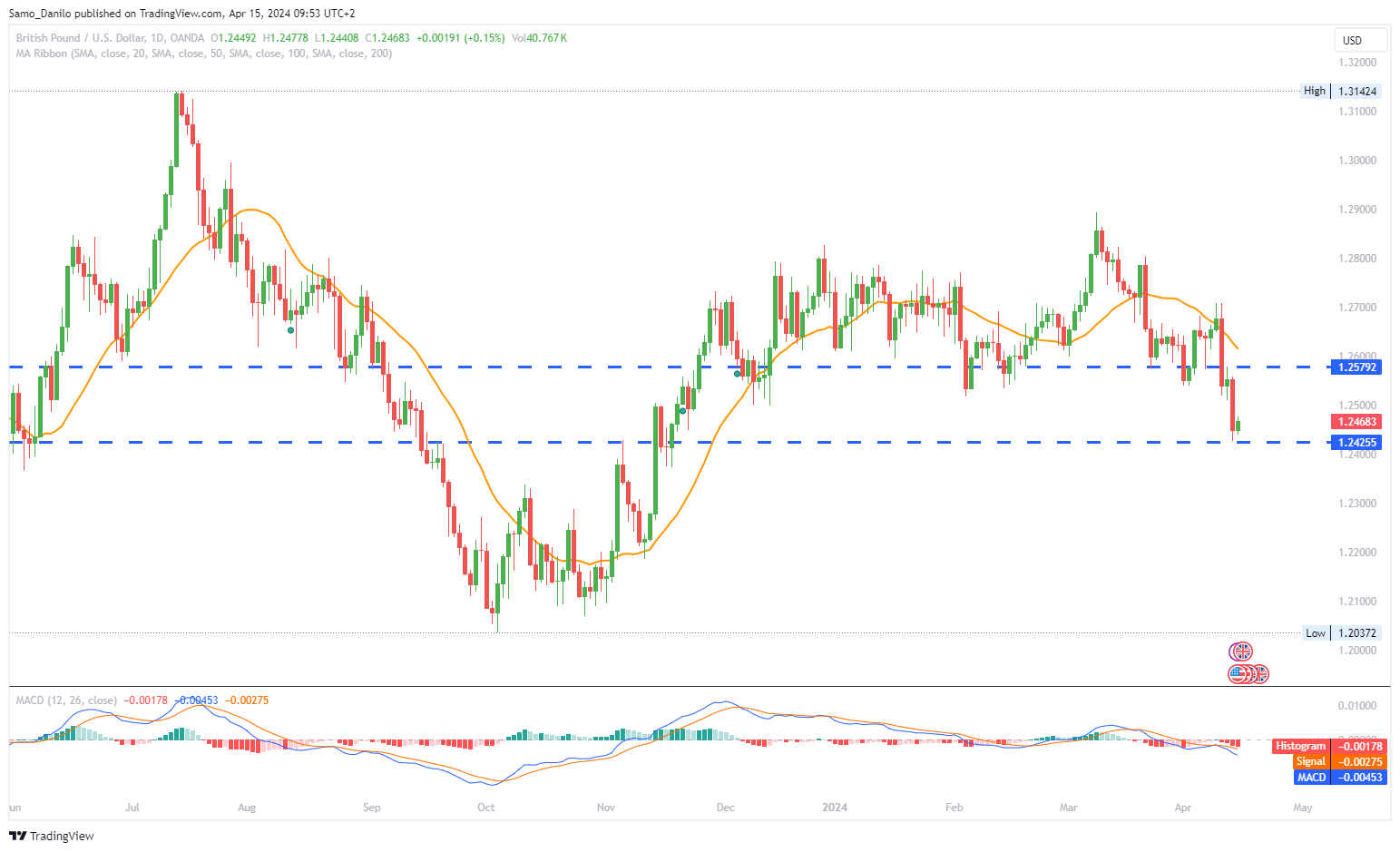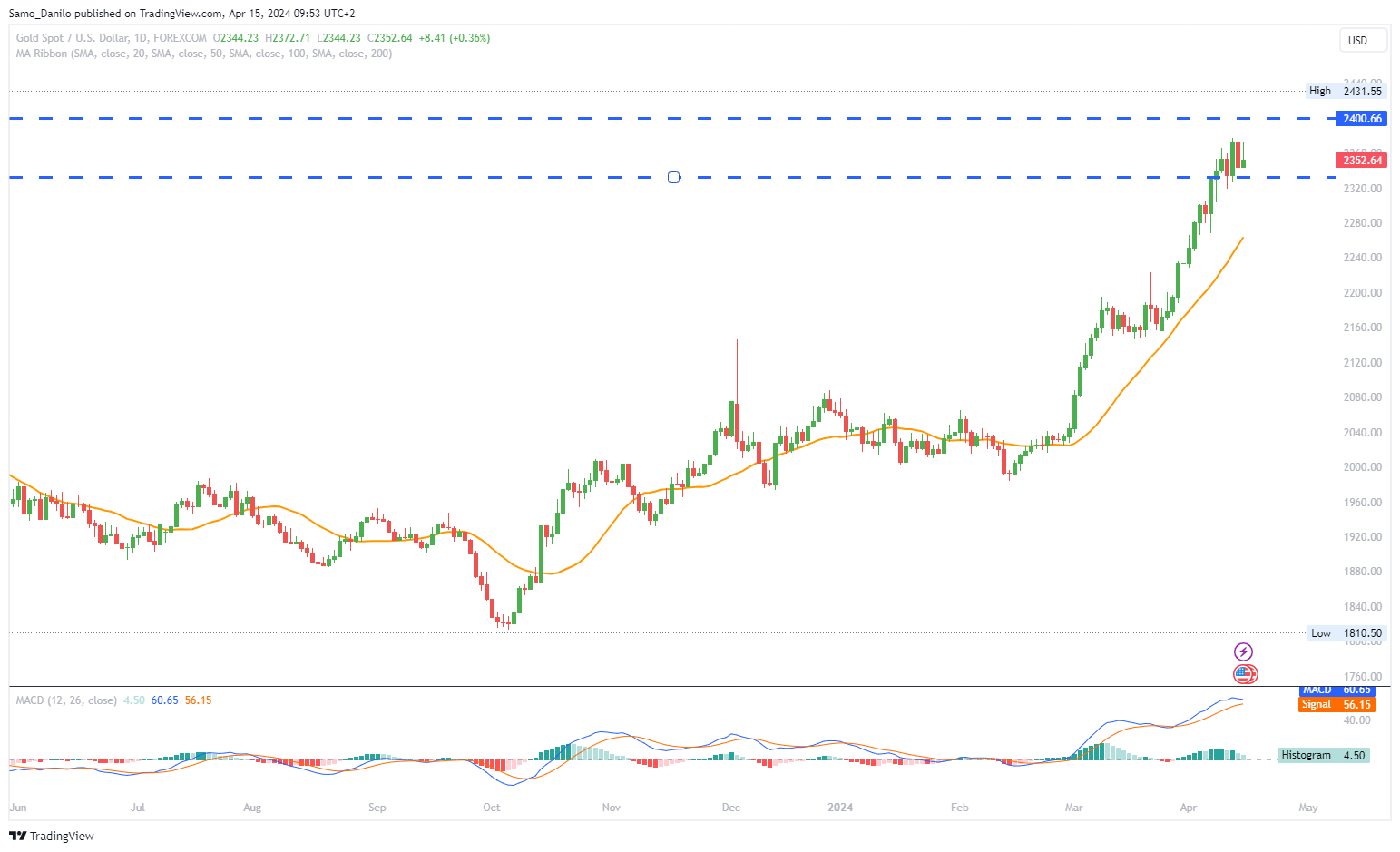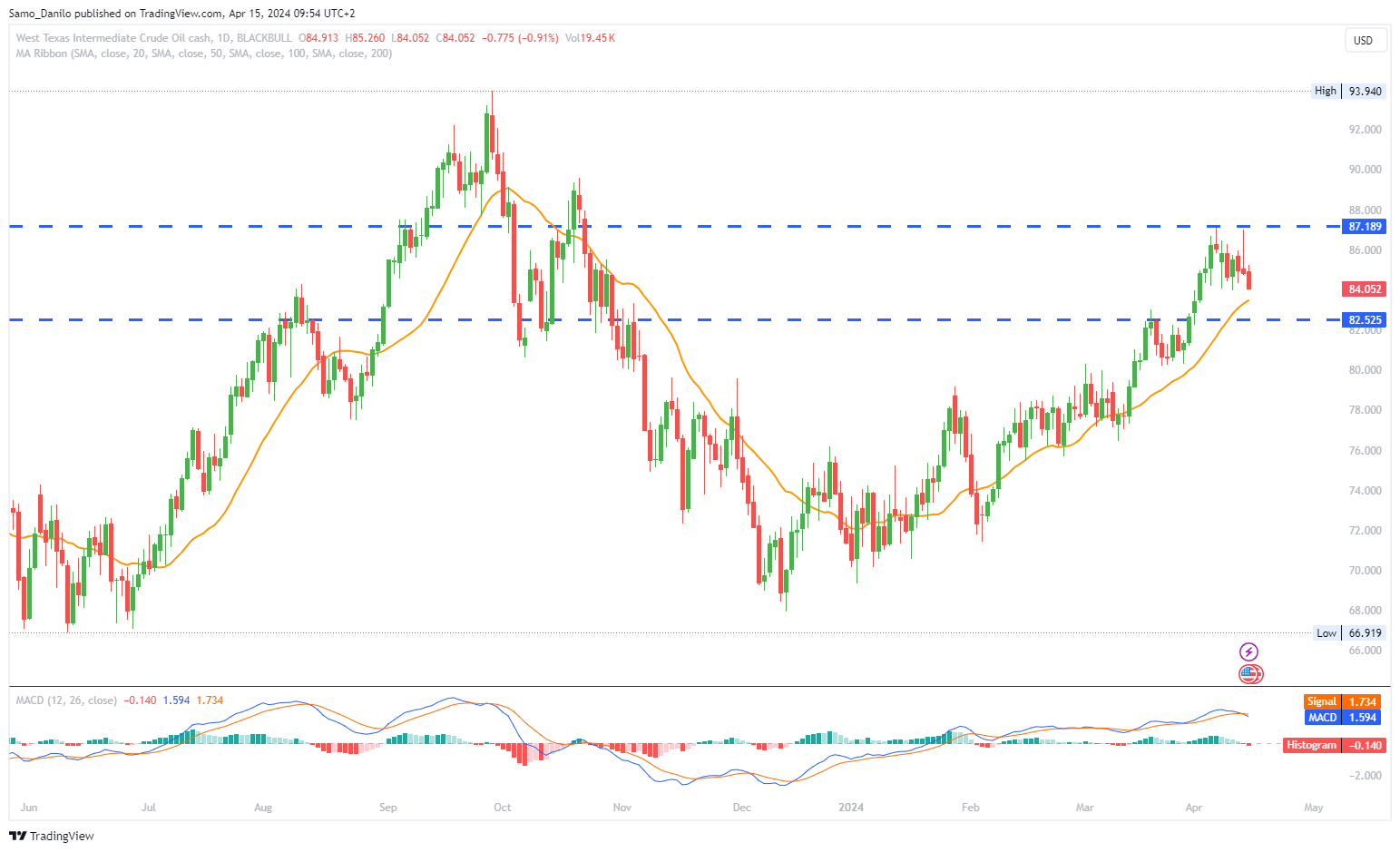EURUSD
- EUR/USD Recovery: EUR/USD has edged up near 1.0650 during the Asian session on Monday, rebounding from a five-month low of 1.0622 reached last Friday. This recovery suggests some resilience in the euro after recent losses against the US dollar.
- USD Strength: The US dollar (USD) gained ground, driven by increased dollar-buying amid geopolitical turmoil. This heightened demand for the dollar exerted downward pressure on the EUR/USD pair, contributing to its recent decline.
- Diverging Monetary Policy Outlooks: The EUR/USD pair faced downward pressure as the European Central Bank (ECB) and the Federal Reserve (Fed) revealed diverging monetary policy outlooks. While the ECB signaled a potential for further easing measures, the Fed's stance has been influenced by robust US inflation and strong macroeconomic indicators, leading to a reconsideration of its plans for monetary easing.
- Impact of Economic Indicators: Investors will closely monitor the release of seasonally adjusted Eurozone Industrial Production data and US Retail Sales figures on Monday. These economic indicators have the potential to influence market sentiment and the direction of the EUR/USD pair, depending on whether they meet, exceed, or fall short of expectations.
Closing statement: Overall, market sentiment toward the EUR/USD pair is influenced by a combination of geopolitical events, monetary policy outlooks, and economic data releases. Traders will continue to assess these factors to gauge the trajectory of the currency pair in the near term.
GBPUSD
- GBP/USD Strength: GBP/USD is trading firmer above 1.2450, indicating relative strength in the British pound against the US dollar. This strength persists despite the ongoing conflict between Iran and Israel over the weekend, which typically boosts demand for safe-haven currencies like the US dollar.
- US Dollar Struggles: Despite geopolitical tensions, the US dollar struggles to gain traction. This suggests that other factors, such as monetary policy outlook and economic indicators, may be influencing the currency pair's dynamics.
- Fed's Monetary Policy Outlook: The Federal Reserve (Fed) appears to be reevaluating its monetary easing plans in light of ongoing US inflation and robust macroeconomic indicators. Comments from Boston Federal Reserve President Susan Collins indicate a potential shift in the Fed's stance, with expectations of fewer rate cuts in 2024 and anticipation of inflation pressures diminishing later in the year.
- Key Events to Watch: Investors will likely observe Federal Reserve Bank of Kansas President Lorie Logan's participation in a panel discussion at the BoJ-IMF conference on Monday. Additionally, traders will pay close attention to the speech by Sarah Breeden, Bank of England's Deputy Governor for Financial Stability, at the Innovate Finance Global Summit 2024 on Monday. These events have the potential to provide further insights into central bank policy and influence market sentiment toward GBP/USD.
| SMA (20) | Slightly Falling |
| |
| RSI (14) | Falling |
|
|
| MACD (12, 26, 9) | Slightly Falling |
|
Closing statement: Overall, market sentiment toward GBP/USD remains influenced by geopolitical developments, monetary policy outlooks, and key speeches from central bank officials. Traders will continue to monitor these factors closely to assess the direction of the currency pair in the near term.
GOLD
- Flight to Safety Boosts Gold: Gold price jumps on a flight to safety after Iran's attack on Israel late Saturday. Geopolitical tensions often drive investors toward safe-haven assets like gold, which is perceived as a store of value during uncertain times. Response to Geopolitical Developments: Traders are closely monitoring geopolitical developments in the Middle East. While the UK, France, and Egypt have condemned Iran's actions, Saudi Arabia has called for restraint, which has somewhat calmed markets on Monday. However, uncertainty persists, and any escalation in tensions could further bolster gold's appeal.
- Weakness in the US Dollar: Gold price is also benefiting from a broadly weaker US dollar (USD). Despite the cautious market environment, the USD shows little strength, providing support to gold prices. A weaker dollar makes gold more attractive to investors holding other currencies.
- Focus on Geopolitical Events: All eyes remain on geopolitical developments in the Middle East for fresh trading impetus in gold price. Any escalation of tensions or new developments could lead to increased demand for gold as a safe-haven asset.
| SMA (20) | Rising |
|
|
| RSI (14) | Rising |
|
|
| MACD (12, 26, 9) | Rising |
|
|
Closing statement: Traders are also monitoring the release of top-tier US Retail Sales data later Monday. This data could have a significant impact on the value of the US dollar and, consequently, on the USD-denominated gold price. Strong retail sales data may strengthen the dollar and potentially weigh on gold prices, while weaker-than-expected data could have the opposite effect.
CRUDE OIL
- Limited Buyer Interest: West Texas Intermediate (WTI) US crude oil prices struggle to attract buyers despite Iran's attack on Israel over the weekend. During the Asian session on Monday, prices oscillate between tepid gains and minor losses, indicating a lack of strong buying interest.
- Geopolitical Tensions: Iran's launch of explosive drones and missiles at Israel late on Saturday, in retaliation for a suspected Israeli attack on its consulate in Syria, contributes to geopolitical tensions in the region. Such events typically raise concerns about potential disruptions to oil supply routes, which can impact oil prices.
- Global Oil Demand Forecast: The crude oil market faces downward pressure as the International Energy Agency (IEA) lowered the 2024 global oil demand growth forecast by 130,000 barrels per day (bpd) to 1.2 million bpd on Friday. This downward revision reflects concerns about weaker-than-expected demand growth, which can weigh on oil prices.
- Impact of Fed Policy Speculation: Speculation that the Federal Reserve (Fed) may delay cutting interest rates due to persistent inflationary pressures could dampen economic activity and reduce fuel consumption. If the Fed adopts a more hawkish stance on monetary policy, it could potentially limit the upside for oil prices.
- Key Pivotal Point: Despite the current challenges, WTI crude oil prices remain within striking distance of a multi-month peak, around the $87.60 area touched on April 5. This level is likely to act as a key pivotal point for determining the near-term direction of oil prices.
| SMA (20) | Rising |
|
|
| RSI (14) | Slightly Rising |
| |
| MACD (12, 26, 9) | Rising |
|
|
Closing statement: West Texas Intermediate (WTI) US crude oil prices face a range of factors influencing their movement, including geopolitical tensions in the Middle East, global oil demand forecasts, and speculation about Federal Reserve monetary policy. While current prices struggle to attract significant buying interest, the proximity to a multi-month peak suggests a critical juncture for the market. Traders will continue to monitor developments closely to assess the direction of crude oil prices in the near term.
DAX
- Mixed Economic Indicators: Economic indicators from China present a mixed picture, contrasting with recent manufacturing sector Purchasing Managers' Index (PMI) numbers. The data signals a potential need for a stimulus package, as exports declined by 7.5% year-over-year in March, following a 5.6% increase in February, while imports fell by 1.9% after declining by 8.2% in February.
- ECB Survey of Professional Forecasters: The European Central Bank (ECB) released the Survey of Professional Forecasters on Friday, indicating expectations for improved economic activity during 2024. Notably, forecasters projected a decline in inflation to 2.4% in 2024 and further to 2.0% in 2025.
- US Consumer Sentiment Numbers: Friday saw the release of US consumer sentiment numbers, which garnered investor attention. The Michigan Consumer Sentiment Index declined from 79.4 to 77.9 in April, suggesting potential concerns about the economic outlook among US consumers.
- Eurozone Industrial Production: Investors will closely monitor industrial production numbers for the Eurozone on Monday. Economists anticipate industrial production to increase by 1.1% in February, following a decline of 3.2% in January. This data will provide insights into the health of the Eurozone's industrial sector.
- ECB Commentary: ECB Chief Economist Philip Lane is scheduled to speak, and his commentary will be of particular interest to investors. Any insights or guidance provided by ECB officials could influence market sentiment and investor decision-making.
| SMA (20) | Rising |
|
|
| RSI (14) | Falling |
|
|
| MACD (12, 26, 9) | Falling |
|
|
Closing statement: In conclusion, the DAX faces a range of factors influencing its performance, including mixed economic indicators from China, ECB forecasts, US consumer sentiment, Eurozone industrial production data, and ECB commentary. While some indicators suggest potential challenges ahead, others point to improvements in economic activity. Investors will closely monitor these developments to gauge the outlook for the DAX in the coming days.




